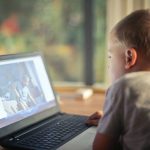Understanding the Importance of Online Safety for Children
Children today are growing up in a digital world, where access to the internet is readily available. While this can be beneficial for learning and entertainment purposes, it also exposes children to various risks and dangers. Online safety for children has become an essential concern for parents and caregivers.
One of the primary reasons why online safety is crucial for children is the potential exposure to inappropriate content. The internet contains a vast amount of information, both suitable and unsuitable for young minds. Without proper monitoring and filtering, children may come across explicit material or engage with individuals who have malicious intent.
Another significant aspect of online safety is protecting children from cyberbullying. With social media platforms becoming increasingly popular among young users, instances of cyberbullying have risen as well. It’s important to educate children about responsible digital citizenship and teach them how to handle such situations effectively.
Additionally, online safety helps prevent identity theft and scams targeting vulnerable individuals like children. Children may unknowingly share personal information that could be exploited by fraudsters or fall victim to phishing attempts disguised as games or contests. By understanding the importance of safeguarding their personal information online, we can help protect our children from these threats.
By prioritizing online safety measures such as parental controls, web browsing monitoring/filtering tools, safe search settings enforcement, limited app/content access, managing screen time/app usage limits, blocking/managing social media access,and utilizing location tracking features on devices; parents can ensure their child’s protection while still allowing them to explore the benefits of technology responsibly.
In conclusion
Exploring the Risks and Dangers of Unmonitored Internet Access
The internet can be a vast and unpredictable place, especially for children who may not fully understand the risks and dangers that exist online. Without proper monitoring and guidance, unmonitored internet access can expose children to various threats such as cyberbullying, inappropriate content, online predators, and scams. It is crucial for parents to be aware of these risks and take necessary precautions to protect their children.
One of the major concerns with unmonitored internet access is the potential for cyberbullying. Children can become victims or even perpetrators of bullying through social media platforms or messaging apps. The anonymity provided by the internet makes it easier for bullies to target their victims without fear of consequences. This kind of harassment can have severe emotional and psychological effects on children, leading to low self-esteem, depression, anxiety, or even suicidal thoughts.
Another danger that comes with unmonitored internet access is exposure to inappropriate content. The unrestricted nature of the internet means that children may stumble upon explicit images or videos while innocently browsing or searching for information. Exposure to such content at a young age can distort their understanding of healthy relationships and sexuality. It is essential for parents to implement parental control features on devices used by their children in order to filter out inappropriate content effectively.
Children are also vulnerable targets for online predators who use tactics like grooming or manipulation in an attempt to exploit them sexually or emotionally. Unmonitored communication channels like chat rooms or instant messaging apps provide opportunities for predators seeking contact with unsuspecting minors. By gaining trust over time, they may coerce children into sharing personal information or engaging in harmful activities offline.
Setting Up Parental Control Features on an iPhone
Setting up parental control features on an iPhone is a crucial step in ensuring the online safety of children. With these controls, parents can have peace of mind knowing that their child’s internet activities are being monitored and filtered for inappropriate content. To set up parental controls on an iPhone, start by accessing the device’s settings.
Within the settings menu, navigate to „Screen Time” and tap on it. Here, you will find various options to manage your child’s app usage and screen time limits. You can set specific daily limits for different categories of apps or individual apps themselves. Additionally, you can restrict certain types of content from being accessed through the App Store or iTunes.
Another important feature to enable is „Content & Privacy Restrictions.” This allows you to customize what your child can access on their device. You can block explicit content, prevent them from making in-app purchases without permission, and even restrict certain functionalities like location services or changing passcodes.
By taking advantage of these built-in parental control features on an iPhone, parents can create a safer digital environment for their children. It is essential to regularly review and update these settings as technology advances and new risks emerge. By doing so, parents can ensure that their children are protected while still enjoying all the benefits that technology has to offer.
Limiting App and Content Access for Child Protection
One effective way to ensure child protection online is by limiting their access to certain apps and content. By setting up parental control features on devices such as iPhones, parents can have more control over what their children can access. This includes restricting access to age-inappropriate apps and content that may pose risks or dangers.
Parental control features allow parents to set restrictions based on age ratings, preventing children from downloading or accessing apps that are not suitable for their age group. Additionally, parents can block specific websites or filter web browsing activities to prevent exposure to inappropriate content. These measures help create a safer online environment for children and protect them from potential harm.
Furthermore, managing app usage and screen time is crucial in maintaining a healthy balance between digital engagement and other aspects of life. Parents can set limits on the amount of time children spend using certain apps or devices each day. This helps prevent excessive screen time, which has been linked to various negative effects on physical health, mental well-being, and social development in children.
By implementing these strategies for limiting app and content access, parents play an active role in protecting their children from potential risks and dangers online. It is important for parents to stay informed about the latest technologies available for parental controls and regularly update settings as needed. Taking proactive steps towards ensuring online safety empowers both parents and children in navigating the digital world responsibly.
Managing Screen Time and App Usage for Healthy Balance
One important aspect of managing screen time and app usage for a healthy balance is setting clear boundaries and limits. It’s essential to establish rules regarding the amount of time children can spend on screens each day, as well as which apps or games they are allowed to use. By doing so, parents can ensure that their children have a balanced lifestyle that includes other activities such as physical exercise, social interactions, and creative pursuits.
Another effective strategy is to encourage regular breaks from screens. Research has shown that prolonged periods of screen time can negatively impact children’s physical health and mental well-being. Encouraging them to take breaks every hour or so not only gives their eyes a rest but also provides an opportunity for them to engage in other activities like reading, playing outside, or pursuing hobbies.
In addition to setting boundaries and encouraging breaks, it’s crucial for parents to be actively involved in monitoring app usage. This includes reviewing the content of apps before allowing children access and regularly checking their activity within these apps. By staying informed about what your child is doing online, you can address any potential issues promptly and guide them towards using age-appropriate content that aligns with your family values.
Monitoring and Filtering Web Browsing Activities
Web browsing activities can expose children to a wide range of risks and dangers online. Without proper monitoring and filtering, they may stumble upon inappropriate content or interact with strangers who have malicious intentions. It is crucial for parents to take proactive steps in ensuring their child’s safety while using the internet.
One effective way to monitor and filter web browsing activities is by utilizing parental control software or tools. These tools allow parents to set restrictions on the types of websites that can be accessed, block certain categories of content, and even track browsing history. By implementing these measures, parents can create a safer online environment for their children and minimize the chances of exposure to harmful material.
In addition to using parental control software, it is important for parents to regularly communicate with their children about safe internet usage. Educating them about potential risks such as cyberbullying, scams, or identity theft will enable them to make informed decisions when navigating the web. By fostering an open dialogue about online safety, parents can empower their children with the knowledge and skills needed to protect themselves from potential threats while browsing the internet.
Enforcing Safe Search Settings to Prevent Inappropriate Content
One effective way to protect children from accessing inappropriate content online is by enforcing safe search settings. Safe search settings can be enabled on popular search engines such as Google, Bing, and Yahoo. By turning on this feature, explicit or adult content will be filtered out from the search results, ensuring a safer browsing experience for children.
To enable safe search settings on Google, for example, users can go to the Search Settings page and select the option to filter explicit results. This will help prevent children from stumbling upon inappropriate images or websites when conducting searches. It is important to note that while safe search filters can significantly reduce exposure to harmful content, they are not foolproof and may occasionally allow some inappropriate material through.
In addition to enabling safe search settings on individual devices or browsers, it is also advisable for parents to install parental control software that includes a safe search feature. These programs often provide more advanced filtering options and allow parents greater control over what their child can access online. By combining both browser-level and software-level safety measures, parents can create a multi-layered approach towards protecting their children from encountering inappropriate content while using the internet.
Blocking and Managing Social Media Access for Children
Social media has become an integral part of our daily lives, but when it comes to children, it is important to establish boundaries and manage their access. With the growing number of social media platforms available, parents need to be proactive in blocking and managing social media access for their children.
One effective way to block social media access is by utilizing parental control features on devices such as smartphones or tablets. These features allow parents to restrict access to specific apps or websites, including popular social media platforms. By setting up these controls, parents can ensure that their children are not exposed to potentially harmful content or interactions online.
In addition to using parental control features, it is also crucial for parents to have open communication with their children about the risks associated with social media. By discussing the potential dangers and explaining why certain restrictions are in place, children will better understand the importance of responsible internet use. This approach fosters trust between parent and child while promoting a safe online environment for everyone involved.
Utilizing Location Tracking for Added Security and Peace of Mind
Location tracking can be a valuable tool for parents seeking to ensure the safety of their children. By utilizing location tracking features on smartphones or other devices, parents can have added peace of mind knowing where their child is at any given time. Whether it’s monitoring their whereabouts during school hours or keeping tabs on their location when they’re out with friends, this technology provides an extra layer of security.
In addition to providing real-time information about a child’s location, location tracking can also serve as a deterrent against potential dangers. Just the knowledge that parents are able to track their movements can discourage children from engaging in risky behavior or venturing into unsafe areas. This feature allows parents to intervene quickly if necessary and provide immediate assistance if a child finds themselves in an uncomfortable or dangerous situation.
Moreover, utilizing location tracking does not mean invading a child’s privacy but rather ensuring their safety in today’s digital age. It enables open communication between parent and child regarding expectations and boundaries. By discussing the importance of online safety and explaining how location tracking contributes to it, parents can foster responsible digital citizenship while still respecting their child’s autonomy. Ultimately, using this technology promotes both security and peace of mind for both parent and child alike.
Open Communication and Education: Nurturing Responsible Digital Citizenship
Open communication and education play a crucial role in nurturing responsible digital citizenship among children. It is essential for parents to establish an open and honest dialogue with their children about the potential risks and dangers of the online world. By engaging in regular conversations, parents can help their children understand the importance of being responsible digital citizens.
Parents should educate their children about appropriate online behavior, including how to protect personal information, avoid cyberbullying, and identify potential scams or malicious activities. Teaching them to think critically before sharing or engaging with content online can empower them to make informed decisions and navigate the internet safely.
Furthermore, it is important for parents to stay updated on current trends and technologies that may impact their child’s online experience. By staying informed themselves, parents can better guide their children through any challenges they may face while using technology. This ongoing education allows parents to provide relevant advice and support as needed without relying solely on restrictive measures like parental controls.
By fostering open communication and providing continuous education about responsible digital citizenship, parents can equip their children with the knowledge and skills necessary to navigate the online world safely. Creating a safe environment where questions are encouraged helps build trust between parent and child, ensuring that both parties are actively involved in promoting positive digital experiences for young users.
Why is online safety important for children?
Online safety is important for children because it helps protect them from cyberbullying, inappropriate content, online predators, and identity theft. It ensures their overall well-being in the digital world.
What are the risks and dangers of unmonitored internet access for children?
Unmonitored internet access for children can expose them to harmful content, cyberbullying, online predators, scams, and privacy invasion. It can also impact their mental health and social interactions.
How can parental control features on an iPhone be set up?
Parental control features can be set up on an iPhone by accessing the settings menu, selecting „Screen Time,” and enabling restrictions. From there, parents can customize settings to limit access to certain apps, websites, and content.
How can app and content access be limited for child protection?
App and content access can be limited for child protection by using parental control features, setting up age-appropriate restrictions, and disabling in-app purchases. Parents can also use app blockers or content filtering software for additional control.
How can screen time and app usage be managed for a healthy balance?
Screen time and app usage can be managed for a healthy balance by setting time limits on specific apps or device usage, creating schedules for device-free activities, and encouraging physical activities or hobbies instead.
How can web browsing activities be monitored and filtered?
Web browsing activities can be monitored and filtered by using internet filtering software or parental control features. Parents can block certain websites, set up safe search settings, and receive activity reports to keep track of their child’s online behavior.
How can safe search settings be enforced to prevent inappropriate content?
Safe search settings can be enforced by accessing the search engine settings (e.g., Google) and enabling the safe search feature. This helps filter out explicit or inappropriate content from search results.
How can social media access be blocked and managed for children?
Social media access can be blocked and managed for children by using parental control apps or features to restrict access to social media platforms. Parents can also set up privacy settings and communicate rules for safe social media usage.
How can location tracking be utilized for added security and peace of mind?
Location tracking can be utilized for added security and peace of mind by using GPS tracking apps or features on mobile devices. This allows parents to know their child’s whereabouts and ensure their safety.
How can open communication and education nurture responsible digital citizenship?
Open communication and education nurture responsible digital citizenship by fostering trust, providing guidance on online safety, promoting responsible online behavior, and encouraging open dialogue about digital experiences. It helps children develop critical thinking skills and make informed decisions in the digital world.




